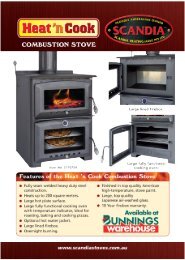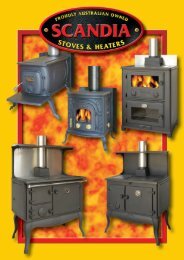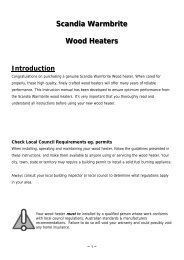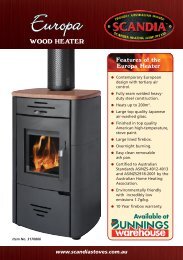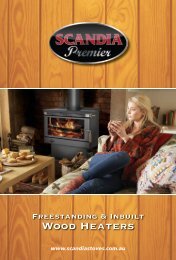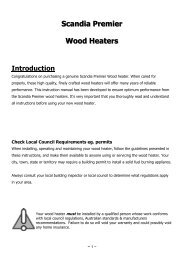Download manual & warranty information - Scandia Stoves & Spares
Download manual & warranty information - Scandia Stoves & Spares
Download manual & warranty information - Scandia Stoves & Spares
You also want an ePaper? Increase the reach of your titles
YUMPU automatically turns print PDFs into web optimized ePapers that Google loves.
1. Locate wood fire in its proposed position according to manufacturers recommendations.<br />
2. Use a plumb bob to mark the ceiling in line with the centre of the flue collar.<br />
3. Check that the outer casing will clear all combustible materials by 25mm. Determine<br />
positions of noggins to avoid cutting, otherwise headers must be installed for strength.<br />
4. Cut a 250mm diameter hole in the ceiling. Directly above cut a hole in the roof to<br />
accommodate outer casing.<br />
5. Fix the angle brackets to the joists so that the drop box (first length of located casing) is<br />
located in the centre of the hole.<br />
6. Position the drop box between the angle brackets, keeping a 25mm clearance to<br />
combustibles. The located end of the drop box must protrude no less than 150mm down<br />
from the ceiling. Fix the drop box to the angle brackets.<br />
7. Add the remaining casings to the required height. Australian/New Zealand Standards state<br />
that “the flue pipe shall extend not less than 4.6m above the top of the floor protector”. If<br />
the flue pipe is within 3 metres of the ridge, the flue pipe must protrude at least 600mm<br />
above the ridge of the roof. If the distance from the ridge is more than 3 metres, the flue<br />
pipe must protrude at least 1000mm above roof penetration. Additional lengths of casing<br />
and flue may be required to achieve this. The flue pipe must be more than 3 metres from<br />
any nearby structure.<br />
8. Install roof flashing (supplied by others).<br />
9. Secure the Ceiling Collar in place using ceramic spacers and screws provided.<br />
10. Insert crimped end of decorative mesh into drop box. The locating tags in one length of<br />
decorative mesh rest on the heater flue collar. The solid heat shield section of the<br />
decorative mesh is to face the wall.<br />
11. Feed stainless steel flue through perforated flue and drop box through to the required<br />
height. Assemble flue pipes tight together as you go ensuring seams are straight. Secure<br />
each joint with three stainless steel rivets spaced equally. Clean any finger prints or oils off<br />
stainless steel flue with methylayted spirits.<br />
12. Trim the inner flue to the same height as the outer casing. Place cover cone and cowl over<br />
stainless steel flue & push cover cone over gal casing. Fix with stainless steel pop rivets.<br />
For connecting into existing Chimney:<br />
The Chimney should be swept prior to installation. The Chimney must not have any hollow<br />
sections present. The connecting flue pipe must be sealed to the chimney with fire cement and<br />
high temperature resistant rope as required. This is usually done into a register (Blanking) plate<br />
with an access door/hatch to enable chimney sweeping. Flue pipe must continue for the full<br />
length of the chimney. The top must be suitably weather sealed with a chimney to flue pipe<br />
adaptor sealed in place with mortar. The flue must be completed with a cowl. Note there should<br />
not be any flue exposed to the elements.<br />
~ 6 ~



